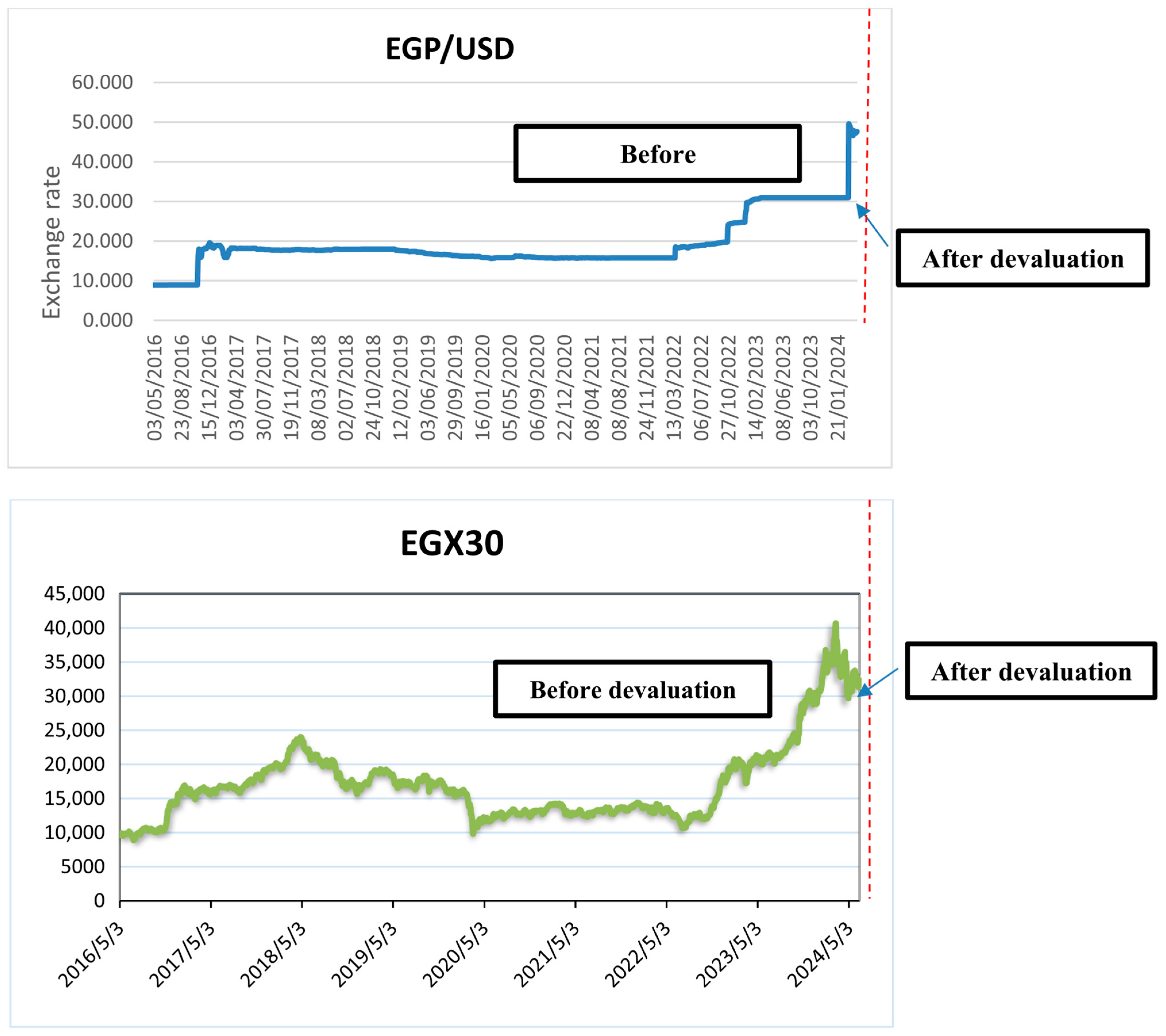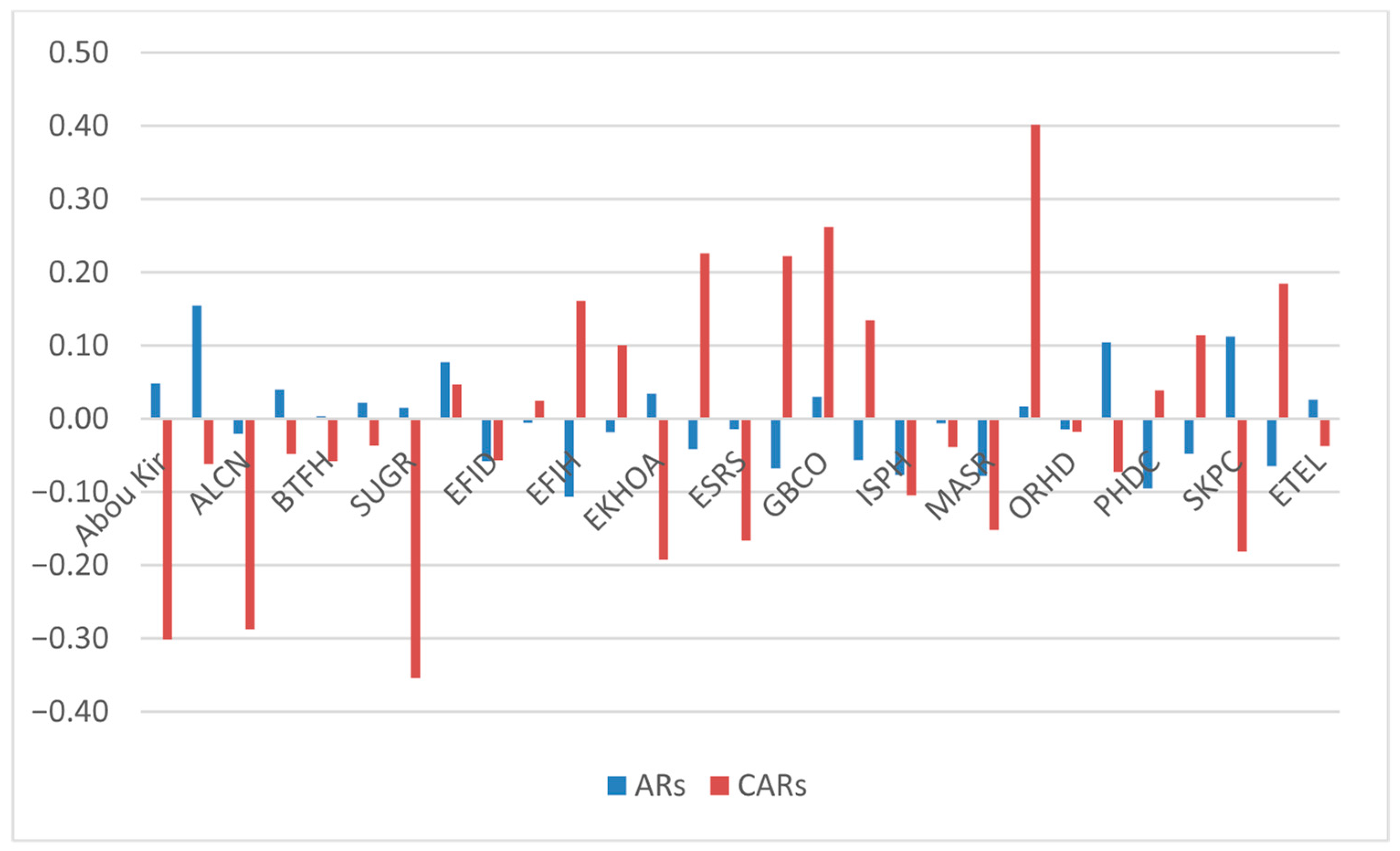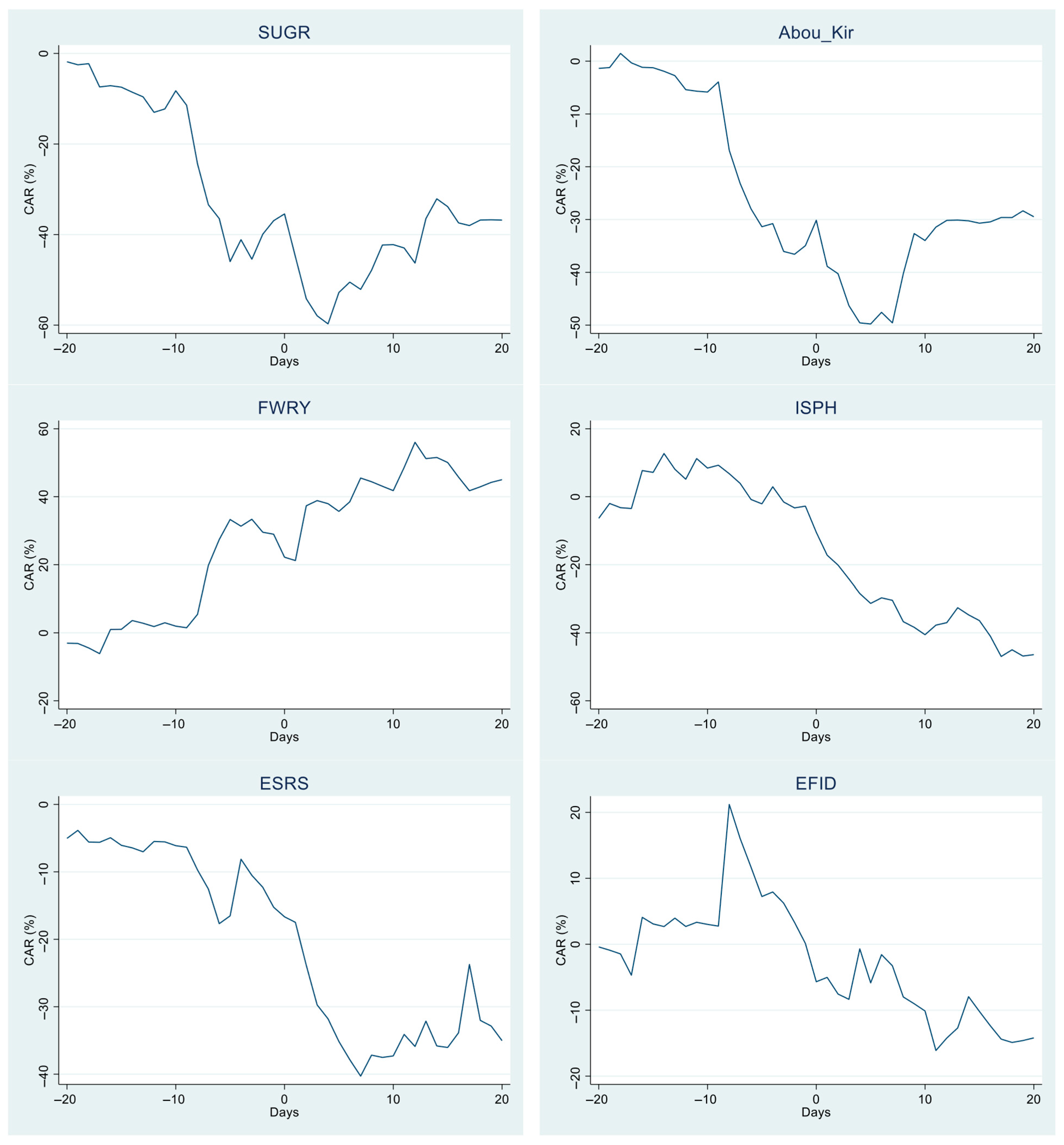How Do Stock Returns Respond to a Currency Devaluation Announcement?
Abstract
1. Introduction
2. Literature Review
2.1. Results for Developed Economies
2.2. Results for Emerging Economies
2.3. Results for BRICS Economies
3. Research Design
3.1. Sample
- Daily price data must be available for the entire study period, and each stock must have at least 100 trading days during the estimation window.
- Stocks must be actively traded, with regular transactions throughout the observation period.
3.2. Data
3.3. Research Method
3.3.1. Event Study Framework
3.3.2. Expected, Abnormal and Cumulative Abnormal Returns
- = actual return on stock i at time t;
- = market index return;
- = OLS parameters estimated over the 100-day estimation window.
σ(ARt) = √[1/(N − 1) × Σi=1N (ARi,t − AARt)2]
- = cross-sectional standard deviation of across firms;
- = t-test statistic.
- = cross-sectional standard deviation of CARi across firms;
- The statistic tests whether CAAR differs from zero.
3.3.3. Hypothesis Testing
- 1.
- Null Hypothesis
- 2.
- Alternative Hypothesis
4. Results
- Short-window analysis: re-estimating AAR and CAAR over [−5, +5] and [−10, +10] day windows.
- Alternative benchmarks: computing market-adjusted and three-factor-adjusted abnormal returns using available factor data.
- Outlier robustness: Winsorizing abnormal returns at the 1st and 99th percentiles and applying sign and median tests.
5. Conclusions
Author Contributions
Funding
Institutional Review Board Statement
Informed Consent Statement
Data Availability Statement
Conflicts of Interest
Appendix A. Firm Names
| N. | Company Name | Reuters Code | ISIN | Sector |
| 1 | Abou Kir Fertilizers | ABUK.CA | EGS512O1C012 | Basic Resources |
| 2 | Abu Dhabi Islamic Bank-Egypt | ADIB.CA | EGS38191C010 | Trade Banks |
| 3 | Alexandria Containers and goods | ALCN.CA | EGS42111C012 | Shipping & Transportation Services |
| 4 | Alexandria Mineral Oils Company | AMOC.CA | EGS380P1C010 | Energy & Support Services |
| 5 | Beltone Holding | BTFH.CA | EGS60121C018 | Non-bank financial services |
| 6 | Commercial International Bank-Egypt | COMI.CA | EGS30201C015 | Banks |
| 7 | Delta Sugar | SUGR.CA | EGS3G0Z1C014 | Food, Beverages and Tobacco |
| 8 | Eastern Company | EAST.CA | EGS37091C013 | Food, Beverages and Tobacco |
| 9 | Edita Food Industries S.A. E | EFID.CA | EGS69082C013 | Food, Beverages and Tobacco |
| 10 | EFG Holding | HRHO.CA | EGS69081C023 | Non-bank financial services |
| 11 | E-finance For Digital & Financial Investments | EFIH.CA | EGS73541C012 | IT, Media & Communication Services |
| 12 | Egyptian International Pharmaceuticals | PHAR.CA | EGS38081C013 | Health Care & Pharmaceuticals |
| 13 | Egyptian Kuwaiti Holding-EGP | EKHOA.CA | EGS33041C012 | Non-bank financial services |
| 14 | Elswedy Electric | SWDY.CA | EGS95001C011 | Industrial Goods, Services and Automobiles |
| 15 | Ezz Steel | ESRS.CA | EGS70321C012 | Basic Resources |
| 16 | Fawry For Banking Technology | FWRY.CA | EGS743O1C013 | IT, Media & Communication Services |
| 17 | GB Corp | GBCO.CA | EGS305I1C011 | Industrial Goods, Services and Automobiles |
| 18 | Heliopolis Housing | HELI.CA | EGS655L1C012 | Real Estate |
| 19 | Ibnsina Pharma | ISPH.CA | EGS691G1C015 | Health Care & Pharmaceuticals |
| 20 | Juhayna Food Industries | JUFO.CA | EGS30901C010 | Food, Beverages and Tobacco |
| 21 | Madinet Masr For Housing and Development | MASR.CA | EGS673T1C012 | Real Estate |
| 22 | Misr Fertilizers Production Company (MOPCO) | MFPC.CA | EGS3C251C013 | Basic Resources |
| 23 | Orascom Construction PLC | ORAS.CA | EGS380S1C017 | Contracting & Construction Engineering |
| 24 | Orascom Development Egypt | ORHD.CA | EGS745L1C014 | Real Estate |
| 25 | Oriental Weavers | ORWE.CA | EGS69101C011 | Textile & Durables |
| 26 | Palm Hills Development Company | PHDC.CA | EGS691S1C011 | Real Estate |
| 27 | QALA For Financial Investments | CCAP.CA | EGS65571C019 | Non-bank financial services |
| 28 | Sidi Kerir Petrochemicals—SIDPEC | SKPC.CA | EGS65591C017 | Basic Resources |
| 29 | T M G Holding | TMGH.CA | EGS39061C014 | Real Estate |
| 30 | Telecom Egypt | ETEL.CA | EGS60111C019 | IT, Media & Communication Services |
References
- Aftab, M., Ali, A., & Hegerty, S. W. (2021). Foreign exchange market pressure and stock market dynamics in emerging Asia. International Economics and Economic Policy, 18, 699–719. [Google Scholar] [CrossRef]
- Ahmed, W. M. (2020). Asymmetric impact of exchange rate changes on stock returns: Evidence of two de facto regimes. Review of Accounting and Finance, 19(2), 147–173. [Google Scholar] [CrossRef]
- Bahar, D., Molina, A., & Santos, M. A. (2018). Fool’s gold: The impact of Venezuelan devaluations in multinational stock prices. Economía, 19(1), 93–128. [Google Scholar] [CrossRef]
- Brown, S. J., & Warner, J. B. (1985). Using daily stock returns: The case of event studies. Journal of Financial Economics, 14(1), 3–31. [Google Scholar] [CrossRef]
- Chang, H. W., Chang, T., & Wang, M. C. (2024). Revisit the impact of exchange rate on stock market returns during the pandemic period. The North American Journal of Economics and Finance, 70, 102068. [Google Scholar] [CrossRef]
- Chortareas, G., Cipollini, A., & Eissa, M. A. (2012). Switching to floating exchange rates, devaluations, and stock returns in MENA countries. International Review of Financial Analysis, 21, 119–127. [Google Scholar] [CrossRef]
- Dahir, A. M., Mahat, F., Ab Razak, N. H., & Bany-Ariffin, A. N. (2018). Revisiting the dynamic relationship between exchange rates and stock prices in BRICS countries: A wavelet analysis. Borsa Istanbul Review, 18(2), 101–113. [Google Scholar] [CrossRef]
- Dang, V. C., Le, T. L., Nguyen, Q. K., & Tran, D. Q. (2020). Linkage between exchange rate and stock prices: Evidence from Vietnam. The Journal of Asian Finance, Economics and Business, 7(12), 95–107. [Google Scholar] [CrossRef]
- Delgado, N. A. B., Delgado, E. B., & Saucedo, E. (2018). The relationship between oil prices, the stock market and the exchange rate: Evidence from Mexico. The North American Journal of Economics and Finance, 45, 266–275. [Google Scholar] [CrossRef]
- Ding, L. (2021). Conditional correlation between exchange rates and stock prices. The Quarterly Review of Economics and Finance, 80, 452–463. [Google Scholar] [CrossRef]
- Dornbusch, R., & Fischer, S. (1980). Exchange rates and the current account. The American Economic Review, 70(5), 960–971. [Google Scholar]
- Elgharib, W. A. (2023). The effect of the COVID-19 announcement on stock returns: Evidence from Egypt. African Journal of Economic and Management Studies, 14(3), 420–431. [Google Scholar] [CrossRef]
- Elmarzouky, M., Moussa, T., & Allam, A. (2025). Cybersecurity disclosure: Board commitment and regulatory impact in the United Kingdom. The International Journal of Accounting. [Google Scholar] [CrossRef]
- Elroukh, A. W. (2024). The reaction of the Egyptian stock market to recurring devaluations: An event study approach. African Journal of Economic and Management Studies, 15(3), 519–533. [Google Scholar] [CrossRef]
- Fama, E. F., Fisher, L., Jensen, M. C., & Roll, R. (1969). The adjustment of stock prices to new information. International Economic Review, 10(1), 1–21. [Google Scholar] [CrossRef]
- Fasanya, I. O., & Akinwale, O. A. (2022). Exchange rate shocks and sectoral stock returns in Nigeria: Do asymmetry and structural breaks matter? Cogent Economics & Finance, 10(1), 2045719. [Google Scholar] [CrossRef]
- Hashmi, S. M., Chang, B. H., Huang, L., & Uche, E. (2022). Revisiting the relationship between oil prices, exchange rate, and stock prices: An application of quantile ARDL model. Resources Policy, 75, 102543. [Google Scholar] [CrossRef]
- Hau, H., & Rey, H. (2004). Can portfolio rebalancing explain the dynamics of equity returns, equity flows, and exchange rates? American Economic Review, 94(2), 126–133. [Google Scholar] [CrossRef]
- Hung, N. T. (2022). Spillover effects between stock prices and exchange rates for the central and eastern European countries. Global Business Review, 23(2), 259–286. [Google Scholar] [CrossRef]
- Hussain, M., Bashir, U., & Rehman, R. U. (2024). Exchange rate and stock prices volatility connectedness and spillover during pandemic induced-crises: Evidence from BRICS countries. Asia-Pacific Financial Markets, 31(1), 183–203. [Google Scholar] [CrossRef]
- Ilzetzki, E., Reinhart, C. M., & Rogoff, K. S. (2019). Exchange arrangements entering the twenty-first century: Which anchor will hold? The Quarterly Journal of Economics, 134(2), 599–646. [Google Scholar] [CrossRef]
- Karim, E., Elmarzouky, M., & Shohaieb, D. (2025). Green revenue generation and sales contribution: Are consumers willing to bear the cost of sustainability? Business Strategy and the Environment. [Google Scholar] [CrossRef]
- Lunawat, R. M., Elmarzouky, M., & Shohaieb, D. (2025). Integrating Environmental, Social, and Governance (ESG) factors into the investment returns of American companies. Sustainability, 17(19), 8522. [Google Scholar] [CrossRef]
- Mintah, E. O., Elmarzouky, M., & Shohaieb, D. (2025). Examining airlines’ environmental and social disclosure: Does board gender diversity matter? Business Strategy and the Environment. [Google Scholar] [CrossRef]
- Mubaiwa, D., & Fasanya, I. (2024). Quantile dependencies between exchange rate volatility and sectoral stock returns in South Africa. Investment Analysts Journal, 53(2), 89–101. [Google Scholar] [CrossRef]
- Naresh, G., Vasudevan, G., Mahalakshmi, S., & Thiyagarajan, S. (2018). Spillover effect of US dollar on the stock indices of BRICS. Research in International Business and Finance, 44, 359–368. [Google Scholar] [CrossRef]
- Neokleous, C. I., & Elmarzouky, M. (2025). Strategic sustainability reporting, impression management and board gender diversity: Evidence from luxury fashion industry. Business Strategy and the Environment. [Google Scholar] [CrossRef]
- Nusair, S. A., & Olson, D. (2022). Dynamic relationship between exchange rates and stock prices for the G7 countries: A nonlinear ARDL approach. Journal of International Financial Markets, Institutions and Money, 78, 101541. [Google Scholar] [CrossRef]
- Patro, D. K., Wald, J. K., & Wu, Y. (2014). Currency devaluation and stock market response: An empirical analysis. Journal of International Money and Finance, 40, 79–94. [Google Scholar] [CrossRef]
- Rai, V. K., & Pandey, D. K. (2022). Does privatization of public sector banks affect stock prices? An event study approach on the Indian banking sector stocks. Asian Journal of Accounting Research, 7(1), 71–83. [Google Scholar] [CrossRef]
- Salisu, A. A., & Ndako, U. B. (2018). Modelling stock price–exchange rate nexus in OECD countries: A new perspective. Economic Modelling, 74, 105–123. [Google Scholar] [CrossRef]
- Sikhosana, A., & Aye, G. C. (2018). Asymmetric volatility transmission between the real exchange rate and stock returns in South Africa. Economic Analysis and Policy, 60, 1–8. [Google Scholar] [CrossRef]
- Sokhanvar, A., Çiftçioğlu, S., & Hammoudeh, S. (2024). Comparative analysis of the exchange rates-stock returns nexus in commodity-exporters and-importers before and during the war in Ukraine. Research in International Business and Finance, 67, 102152. [Google Scholar] [CrossRef]
- Strong, N. (1992). Modelling abnormal returns: A review article. Journal of Business Finance & Accounting, 19(4), 533–553. [Google Scholar] [CrossRef]
- Umoru, D., Effiong, S. E., Umar, S. S., Okpara, E., Ugbaka, M. A., Otu, C. A., Ofie, F. E., Tizhe, A. N., & Ekeoba, A. A. (2023). Reactions of stock returns to asymmetric changes in exchange rates and oil prices. Corporate Governance and Organizational Behavior Review, 7(3), 42–56. [Google Scholar] [CrossRef]
- Xie, Z., Chen, S. W., & Wu, A. C. (2020). The foreign exchange and stock market nexus: New international evidence. International Review of Economics & Finance, 67, 240–266. [Google Scholar] [CrossRef]
- Zarei, A., Ariff, M., & Bhatti, M. I. (2019). The impact of exchange rates on stock market returns: New evidence from seven free-floating currencies. The European Journal of Finance, 25(14), 1277–1288. [Google Scholar] [CrossRef]






| Security | CAAR [−20, 0] | CAAR [0, 20] | CAAR [−20, 20] |
|---|---|---|---|
| Abou_Kir | −30.13% ** | 5.47% | −29.47% |
| ADIB | −6.21% | −10.19% | −31.84% * |
| ALCN | −28.77% | −14.99% | −41.68% |
| AMOC | −4.83% | −5.23% | −14.02% |
| BTFH | −5.79% | 14.97% | 8.83% |
| COMI | −3.67% | 14.16% | 8.32% |
| SUGR | −35.44% ** | 0.13% | −36.81% |
| EAST | 4.71% | −18.05% | −21.08% |
| EFID | −5.68% | −14.31% | −14.20% |
| HRHO | 2.43% | −10.77% | −7.74% |
| EFIH | 16.09% | 9.23% | 36.00% ** |
| PHAR | 10.02% | −8.94% | 2.97% |
| EKHOA | −19.26% | −7.62% | −30.29% |
| SWDY | 22.56% ** | −15.27% | 11.45% |
| ESRS | −16.66% | −19.79% | −35.03% * |
| FWRY | 22.19% ** | 16.07% | 45.02% *** |
| GBCO | 26.18% * | 4.95% | 28.14% |
| HELI | 13.43% | −11.15% | 7.95% |
| ISPH | −10.48% | −43.64% ** | −46.42% * |
| JUFO | −3.88% | −11.27% | −14.49% |
| MASR | −15.21% | −20.61% | −27.99% |
| ORAS | 40.15% ** | −10.77% | 27.69% |
| ORHD | −1.81% | −8.95% | −9.29% |
| ORWE | −7.29% | 17.48% | −0.24% |
| PHDC | 3.86% | −29.20% * | −15.83% |
| CCAP | 11.40% | −5.85% | 10.35% |
| SKPC | −18.16% | 13.12% | −16.27% |
| TMGH | 18.45% | −23.98% | 0.96% |
| ETEL | −3.76% | −2.80% | −9.16% |
| Ptf CARs n 1 (29 securities) | 0.27% | −6.22% | −5.76% |
| CAAR group 1 (29 securities) | 1.03% | −5.29% ** | −4.14% |
Disclaimer/Publisher’s Note: The statements, opinions and data contained in all publications are solely those of the individual author(s) and contributor(s) and not of MDPI and/or the editor(s). MDPI and/or the editor(s) disclaim responsibility for any injury to people or property resulting from any ideas, methods, instructions or products referred to in the content. |
© 2025 by the authors. Licensee MDPI, Basel, Switzerland. This article is an open access article distributed under the terms and conditions of the Creative Commons Attribution (CC BY) license (https://creativecommons.org/licenses/by/4.0/).
Share and Cite
Elgharib, W.A.; Elmarzouky, M.; Shohaieb, D. How Do Stock Returns Respond to a Currency Devaluation Announcement? J. Risk Financial Manag. 2025, 18, 663. https://doi.org/10.3390/jrfm18120663
Elgharib WA, Elmarzouky M, Shohaieb D. How Do Stock Returns Respond to a Currency Devaluation Announcement? Journal of Risk and Financial Management. 2025; 18(12):663. https://doi.org/10.3390/jrfm18120663
Chicago/Turabian StyleElgharib, Wael Ahmed, Mahmoud Elmarzouky, and Doaa Shohaieb. 2025. "How Do Stock Returns Respond to a Currency Devaluation Announcement?" Journal of Risk and Financial Management 18, no. 12: 663. https://doi.org/10.3390/jrfm18120663
APA StyleElgharib, W. A., Elmarzouky, M., & Shohaieb, D. (2025). How Do Stock Returns Respond to a Currency Devaluation Announcement? Journal of Risk and Financial Management, 18(12), 663. https://doi.org/10.3390/jrfm18120663








